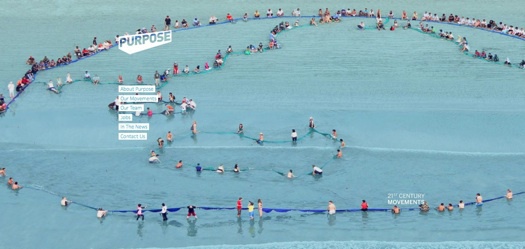
Home page of Purpose, a new organization that consults on the formation of movements and helps spur of few of its own.
His mother wanted him to grow up to be a doctor, a lawyer or an architect, Jeremy Heimans says with a laugh. Instead, the Australian native became what he calls a “movement entrepreneur,” an expert in using the internet to build social movements around pressing issues. He launched GetUp.org, a grassroots organizing force in his homeland that has more members than all the country’s political parties combined, and he co-founded Avaaz.org, a global online pressure group (avaaz means voice in languages from Hindi to Farsi to Bosnian). His latest venture is Purpose, a New York–based consultancy on movement formation and development that has a not-for-profit arm that launches its own campaigns; one of them, AllOut.org, promotes LGBT rights worldwide and recently helped quash a bill in Uganda that would have made being gay punishable by death. Last month the Ford Foundation presented Heimans with one of its 12 Visionaries Awards, an honor that comes with a $100,000 grant, calling the 33-year-old “a next generation leader.” Here, excerpts from a recent interview with Heimans, conducted in an admittedly old-fashioned way — by phone.
Not long ago, people rallying around a cause might have organized a march on Washington. What are the 21st-century methods of making social change?
The good news is that technology has lowered the barriers to power. Thirty years ago, you needed to be a person with institutional power, or you had to be someone like Martin Luther King, with a vast network of churches, to have an impact. In the 21st century you don’t need to be the president of the United States or have a cult of personality. You still have to have a compelling message, a powerful brand, do storytelling in strong ways. But now, using the internet, you can unify people across geography to build a global movement. People can be anywhere in the world, and you can aggregate them according to their passion and unify them in a transnational community that didn’t exist before. And you can coordinate the passion of those people more quickly. If something happens in the world that requires a response within 48 hours, you can mobilize people at a moment’s notice.
What are the tools you’re deploying to do this?
From a tech perspective, they’re not terribly high-tech. Text messaging is one of the more effective methods. Email is still a powerful way of driving people to take action. The basic laws of physics haven’t changed. To get people involved initially, you want the entry point to be easy and accessible. We don’t make you sign a huge manifesto. You take a simple action, like signing a petition. That begins a process where we move you up a curve of commitment over time.
How important are Facebook and Twitter?
Social media are really important — it’s the way word-of-mouth happens today. At 5 a.m. on a Monday morning All Out launched an action around an anti-gay bill heading to the Ugandan parliament. Because of the virality of the campaign — it was passed along on Twitter and Facebook — 200,000 people had signed our petition by end of first day. In four days there were more than half a million people. Now we have this huge community of people all over world primed to take action.
Clearly, the upside of web-based communication is that you can act quickly and involve people all over. What’s the downside?
Facebook and Twitter are not ends in themselves, just platforms. You don’t just want a bunch of YouTube videos about an issue that people watch and get excited about and then have no systematic way to engage them after that. You still need a robust strategy. In the early internet or pre-internet days, there were huge mobilizations, but then the day after a big protest people went home and didn’t have any way to channel their energy. We are building long-term movements so that people can be re-engaged to take other actions.
When did you start Purpose?
Two years ago. We hired our first person in June ’09, and there are now more than 40 people on staff. We have political organizers, behavioral economists, interaction designers, technologists, brand strategists who know how to tell stories, people who understand business.
Sounds a bit like a marketing, PR, or advertising firm, actually.
The tools of marketing and design are critical to our work. We have clients who look to us because we’re good at building mass participation. The difference is that we only do work that’s consistent with our social mission, which is finding new ways of combining the power of citizens and consumers. A mayonnaise company came to us to build a movement around real food and local food. But we said you aren’t real and you aren’t local. We didn’t take the job.
You’re a for-profit company and a not-for-profit at the same time. How does that work?
There isn’t a clear analog to what we do. We have a company that provides services, that helps organizations build movements and build movement technologies. We form partnerships to do this. Right now we’re working with Jamie Oliver on a national movement around food policies — policies that are impacting childhood obesity — and food culture. And we have an independently operating foundation called the Purpose Foundation to do projects like All Out.
What else is Purpose focusing on now?
We’re working with the BBC on a new social action platform on global poverty. We’re working with a partnership of NGOs in Rio de Janeiro on a citizen movement called Meu Rio — My Rio. We want to make sure that ordinary Cariocas have a voice in the development that occurs there leading up to the 2014 World Cup and the 2016 Olympics. Global Zero is a long-term campaign with 300 world leaders to eliminate nuclear weapons. We’re trying to reintroduce the issue of nuclear disarmament.
How do you plan to use the Ford Foundation money?
I’d like to use the funds to promote the idea of movement entrepreneurship and to incubate a couple more movements. We’ve been talking in a broader way about the future of consumer activism, of organizing people not as citizens but as consumers. There’s been a lot of organizing of consumers to get people to buy more stuff. But we’re thinking about how you mobilize consumers to help shift production from the goods of an unsustainable past towards things that would be part of a sustainable future — like electric cars, renewable energy, and sustainable food. We think there’s a massive untapped opportunity to organize consumers for social change.


Comments [1]
check this out: http://www.bcreative.al/
bye
06.16.11
04:55